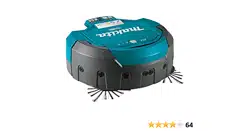Loading ...
Loading ...
Loading ...

15 ENGLISH
Conning the Robotic Cleaner to a particular
area
Boundary tape (Fig. L-1) and the boundary-sensing
feature that employs infrared sensors, enable the
Robotic Cleaner to avoid the following areas (Fig. L-2):
• An area that is divided into sections because the
entireoorissolargethattheRoboticCleaner
cannotcleantheooratatime
• An area where fragile articles are present that the
Robotic Cleaner could damage
• Anareafullofgoodsandxtures,barriers,orof
an intricate shape, resulting in the Robotic Cleaner
getting stuck
• An area in the vicinity of a staircase
• An area with a low barrier that the Robotic Cleaner
canclimboverandfalldowntoaloweroor,orthat
the Robotic Cleaner will get stuck on
Preparations
1. Selectanevenandsmoothsurfaceontheoor
where you plan to place the boundary tape, and
then clean the surface.
2. Place the boundary tape so that the side with the
shortbarsisadjacenttothecleaningareaandthere
arenoairbubblesbetweenthetapeandtheoor.
NOTICE: Be sure to use only genuine boundary tape.
Using a tape other than the genuine article might risk
malfunctioning of the boundary-sensing feature.
NOTICE: Do not place the boundary tape on uneven
surfaces that may cause erroneous detection or
on surfaces where the tape may become soiled or
damaged.
NOTICE: Be aware that some adhesive agent may
remainonoors,ortheoormaybedamagedwhen
you remove the boundary tape.
NOTICE: Keep the boundary tapes clean and check
if any positions torn or ripped. If the tape is damaged,
replace it.
WARNING: Do not place the boundary tape in
any area where an accident occurs resulting from
the Robotic Cleaner entering the area or the Robotic
Cleaner falling down from the area. In such a case,
placeobjectswhoseheightis15cmorhigherand
that are heavy enough to withstand the impact of the
Robotic Cleaner, in place of the boundary tapes.
Operations
In standby mode, press the Boundary sensor button
(Fig. F-11) on the Robotic Cleaner to activate the
boundary sensor (Fig. O-2).
The lamp (Fig. F-11) lights up.
To deactivate the boundary sensor, press
the
Boundary sensor button again.
NOTICE: This setting is not possible in sleep mode
with the auto-on timer activated.
MAINTENANCE
CAUTION: Always make sure that both battery
cartridges are removed before attempting to perform
cleaning, inspection or maintenance.
NOTICE: Be sure to take out the dust box before
turning over the Robotic Cleaner to prevent dust and
dirt from dropping out of the main brush opening.
NOTICE: Be sure to spread a rug or other cushioning
materialontheoortopreventdamagetotheoor
and the Robotic Cleaner (Fig. B).
NOTICE: Never use hot water (higher than 40°C
(104°F)), gasoline, benzine, thinner, alcohol or the
like. Discoloration, deformation, or cracks may result.
To maintain product SAFETY and RELIABILITY,
repairs,anyothermaintenance,oradjustmentshould
be performed by Makita Authorized or Factory Service
Centers, always using Makita replacement parts.
Cleaning the side brushes
(Figs. A, M-1)
• Threads and hairs tangled in the bristles of the
side brushes may cause the brush to stop rotating.
Remove them using tweezers or similar tools.
• If the bristles are deformed or missing, replace with
the spare brush (see “Installing the side brushes” for
details).
Cleaning the wheels
• Remove threads and hairs from the drive wheels
(Fig. M-2) using tools such as tweezers and
scissors. Turning the wheel facilitates the cleaning.
• Remove threads and hairs from the swivel wheels
(Fig. M-3) using tweezers, scissors, or similar tools.
NOTICE:Caremustbetakensothatngersarenot
caught between the wheels and the Robotic Cleaner
body.
Cleaning the main brush
Removing the side brushes (see “Installing the side
brushes” for details) facilitates the following work.
1. Remove four screws (Fig. N-1), and then the bottom
plate (Fig. N-2) and main brush (Fig. N-3).
2. Wipe the bottom plate (Fig. N-2) with a cloth slightly
moistened with mild detergent or wash the plate in
water if necessary.
3. Remove threads and hairs from the main brush (Fig.
N-3) using scissors and wash the main brush in
water if necessary.
4. Wipe the inside of the vacuum vent (Fig. N-4) with a
cloth slightly moistened with mild detergent.
5. To replace the main brush, align the protruding
portion (Fig. N-5) on the right end of the main brush
with the indentation on the right shaft bush (Fig.
N-6),andtheninsertthemainbrushtojointhem
together.
6. Insert the left square end of the main brush (Fig.
N-7) into the left square shaft bush (Fig. N-8).
Loading ...
Loading ...
Loading ...
